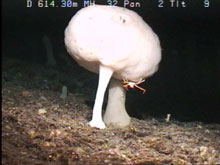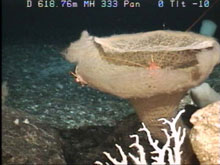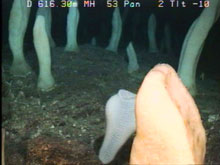HURL
2002
Wierd
Sponges
(9/14/02)
Posted
by Rachel Shackelford
 We
finished our work at Brooks
Bank yesterday. A total of three Pisces (sub) dives
and six ROV (remotely operated vehicle) dives. All three
Pisces dives were in the same area - Northeast Brooks. They
overlap each other significantly so we effectively have
sampled it in triplicate with two observations for each
sample, which will lend a lot of confidence to the results.
The ROV dives were scattered around the bank a bit more.
We
finished our work at Brooks
Bank yesterday. A total of three Pisces (sub) dives
and six ROV (remotely operated vehicle) dives. All three
Pisces dives were in the same area - Northeast Brooks. They
overlap each other significantly so we effectively have
sampled it in triplicate with two observations for each
sample, which will lend a lot of confidence to the results.
The ROV dives were scattered around the bank a bit more.
As
I mentioned earlier, the Pisces dives take up the entire
day, going into the water around 8:00 am or so in the morning
and getting back to the surface around 4:00 or 4:30 pm in
the afternoon. Once the sub is on deck, any samples that
were collected are put in alcohol and then it is time for
dinner. The submersible support crew goes to work making
sure that  everything
is in order for the next dive. The oxygen bottle has to
be filled, batteries charged, repairs made, new sodasorb
(the stuff that soaks up carbon dioxide in the sub) loaded,
etc. Meanwhile the ROV support crew has been making sure
that it is ready to go. By about 7:00 pm or so, the ROV
goes into the water. Once the ROV is launched everyone gathers
in the tracking room. Three ROV pilots rotate positions
every half hour; one sits at the control console and drives
the vehicle with a joystick, another watches the sonar screen
and controls the winch, the third gets to rest a bit and
stays on hand as backup. Once the ROV package gets close
to the bottom (we have to watch the depth closely so it
doesn't go crashing into the ocean floor), the winch is
stopped and the pilot carefully guides the vehicle out of
its 'garage.' Several other people fill the room, directing
the pilots to steer toward biological targets, challenging
them to get as close as they can. Biologists gather around
the TV screens trying to identify deep-sea organisms as
the ROV flies over them. At the end of the dive, the pilot
must guide the ROV back into its protective cage. The starting
and ending points of each dive can be the most complicated
and potentially dangerous for the ROV.
everything
is in order for the next dive. The oxygen bottle has to
be filled, batteries charged, repairs made, new sodasorb
(the stuff that soaks up carbon dioxide in the sub) loaded,
etc. Meanwhile the ROV support crew has been making sure
that it is ready to go. By about 7:00 pm or so, the ROV
goes into the water. Once the ROV is launched everyone gathers
in the tracking room. Three ROV pilots rotate positions
every half hour; one sits at the control console and drives
the vehicle with a joystick, another watches the sonar screen
and controls the winch, the third gets to rest a bit and
stays on hand as backup. Once the ROV package gets close
to the bottom (we have to watch the depth closely so it
doesn't go crashing into the ocean floor), the winch is
stopped and the pilot carefully guides the vehicle out of
its 'garage.' Several other people fill the room, directing
the pilots to steer toward biological targets, challenging
them to get as close as they can. Biologists gather around
the TV screens trying to identify deep-sea organisms as
the ROV flies over them. At the end of the dive, the pilot
must guide the ROV back into its protective cage. The starting
and ending points of each dive can be the most complicated
and potentially dangerous for the ROV.
The
ROV dives tend to be a bit shallower than the sub dives
- 100 to 200 m vs. 200 to 400 m in the sub. The last ROV
dive,  however,
was done at 600 m. This was one of the coolest dives yet.
There were vast field of cylindrical white Symparella sponges;
it looked like something out of a Dr. Seuss book or a Salvador
Dali painting. We didn't see very many fish down this deep,
but the few we did see were pretty neat. There were several
different types of macrourids (rat tail fish) - a few of
which we weren't able to identify. They may be new records
for Hawai‘i, and at the very least, they are new records
for the HURL database. We also saw a purple coral that no
one was able to identify; we know of a similar-looking blue
one, but this one was distinctly purple. It is fun to watch
the biologists on board get giddy and excited when they
see fish or coral that they can't recognize.
however,
was done at 600 m. This was one of the coolest dives yet.
There were vast field of cylindrical white Symparella sponges;
it looked like something out of a Dr. Seuss book or a Salvador
Dali painting. We didn't see very many fish down this deep,
but the few we did see were pretty neat. There were several
different types of macrourids (rat tail fish) - a few of
which we weren't able to identify. They may be new records
for Hawai‘i, and at the very least, they are new records
for the HURL database. We also saw a purple coral that no
one was able to identify; we know of a similar-looking blue
one, but this one was distinctly purple. It is fun to watch
the biologists on board get giddy and excited when they
see fish or coral that they can't recognize.
After
cruising along the bottom for over two hours, the ROV pilots
noticed an oil alarm. It looked like we might have an oil
leak so we had to abort the dive. Everybody was satisfied
with what we had seen, though. The ROV crew started bringing
the vehicle back up to the ship, where they would diagnose
and fix the problem. Something always seems to break or
malfunction on these vehicles, but the crew can always fix
it. They do an amazing job.